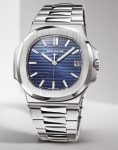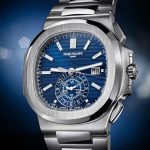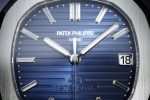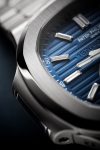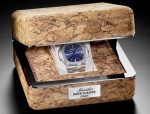Patek Philippe
Patek Philippe Nautilus 40th Anniversary
Patek Philippe
Patek Philippe Nautilus 40th Anniversary
As anniversaries go, that of the Nautilus is one worth noting, for it was the timepiece that Patek Philippe developed as its contender in the “sport/luxury” genre. Whether Audemars Piguet actually knew what they were doing when they launched the Royal Oak a few years earlier, they created a genre that Patek clearly felt would blossom. It is now one of the most powerful sectors, embracing everything from the Rolexes that preceded both, to the Big Bands and Richard Milles and Urwerks that emerged in the intervening years.
Looking back to 1976, it’s incredible to see just how little, design-wise, the Nautilus has changed since its inception. Another aesthetic triumph like the Royal Oak, it is a vivid example of the old adage, “If it ain’t broke, don’t fix it.” After four decades, even a first-series Nautilus looks current – and that in itself defines its classic status.
Philippe Stern, sensing that the sport/luxury watch was a category that could suit Patek, would enter the field with a visionary creation from Gérald Genta, one of the most gifted watch designers of the 20th century. The original 42mm Nautilus Ref. 3700/1A “Jumbo” was larger than the norm for men’s watches and made of stainless steel, which went against the trend for slimmer, gold watches. It was water resistant to 120 meters, serving the needs of Philippe Stern, who was a passionate skipper and successful regatta contestant on Lake Geneva.
Salient features of the Nautilus Ref. 3700/1A included two lateral case extension ridges at 9 and 3 o’clock, which form the two flanges that joined the two-part case ensemble. This added to the sense of security, primarily against the ingress of moisture and dust, when compared to conventional cases that consist of three parts. Inspired by the locking mechanisms of portholes on sea liners, it formed the Nautilus’ distinctive look, imparting it with a maritime air in support of its name as well as its function.
Its crystal was framed by an octagonal bezel with gently curving sides and rounded corners, satin-finished on the upper plane and mirror-polished on the beveled flanks. The solid stainless steel bracelet featured the same matte/mirror effect. The bracelet’s form, despite its inherent ruggedness, was surprisingly supple on the wrist.
Although qualifying as a “tool” watch by virtue of its durability, the Nautilus was also handsome. The dial, in a blue-tint charcoal, stood out with an engraved, horizontal pattern, accented by applied luminous baton hour markers to match the slender luminous baton hands. For this opus, the name “Nautilus” was a perfect fit, whether it was associated with cephalopod mollusks and their beautiful, spiral shells or with Captain Nemo’s submarine, which Jules Verne dispatched on a perilous expedition in his books, Twenty Thousand Leagues Under the Sea and The Mysterious Island.
Pioneers don’t always have an easy start. The Nautilus was launched – and here, “launched” is appropriate – with the ad slogans, “One of the world’s costliest watches is made of steel” and “It goes with a wetsuit as well as with a tuxedo.” It worked: despite the then-radical notion of a costly, steel sport watch, within just a few years, it turned out that the notion of “casual” AND “elegant” over-rode the concerns of the larger-than-normal size of the watch and the use of stainless steel as the case material at its price point. Those who possess an original Nautilus Ref. 3700/1A today own not just a milestone in horological history, but also a precious collector’s piece envied by thousands of watch enthusiasts.
Key debuts included the 1980 Ladies’ Nautilus Ref. 4700/51J, and 1981’s Ref. 3800/1 and Ref. 3900/1 midsize models. These were followed in 1996 by watches with Roman numerals (Ref. 3800/1JA) and the first with a leather strap, foreshadowing the launch in 1997 of the Aquanaut, effectively Nautilus’ “kid sister.” The first complicated was the Nautilus Ref. 3710/1A with a winding zone indicator IZR, presented in 1998, followed in 2005 by the Ref. 3712/1A, the first Nautilus with a moon-phase display and a power-reserve indicator.
To commemorate its 30th anniversary in 2006, the design of the Nautilus collection for men was subtly reworked, the two-part case superseded by three-part construction, crowned with the launch of the Ref. 5980/1A self-winding flyback chronograph model. The 2010 launches introduced the Ref. 5726A Annual Calendar Nautilus with a leather strap, followed in 2012 by the Ref. 5726/1A version with bracelet, and Ref. 5980R, the first chronograph with a leather strap.
In 2009, in cooperation with Gérald Genta, the ladies’ collection was delicately reworked and updated. New versions with leather straps and steel bracelets, as well as more feminine dials, were added in 2013. The first self-winding Ladies’ Nautilus (Ref. 7118/1A) in steel without diamonds was presented in 2015.
Birthday presents
After keeping its legions of fans in suspense, Patek Philippe has announced two special Nautiluses to mark the 40th Anniversary, both, of course, holding the Patek Philippe Seal. The first is Ref. 5711/1P offered in a limited edition of 700 pieces in platinum, retailing for $113,440. For this timepiece, Patek Philippe has employed the self-winding 324-SC movement with Gyromax® balance and Spiromax® balance spring, which pays tribute to the original Nautilus Ref. 3700/1A “Jumbo” from 1976.
Accompanying the Ref. 5711/1P at the birthday party is the Ref. 5976/IG Flyback Chronograph in 18-karat white gold, which retails for $96,390. The 18-karat white gold 49.25mm case makes a size statement that could usurp the name “Jumbo”. Inside is the CH 28-520 self-winding flyback chronograph movement with 327 parts, including the brand’s proprietary Spiromax® balance spring made of Silinvar®. The watch is also exceptionally precise, promising accuracy of -3/+2 seconds per day. Only 1,300 examples will be produced.
Whenever Patek Philippe issues anniversary models, they sell out swiftly and lengthen the “wants” lists maintained by collectors. To ensure that these are noticed, each dial is subtly inscribed with the notation: “1976 – 40 – 2016.” Even this message is achingly “Patek-ish” as you have to look closely to see it. No shouting from the rooftops. Then again, Patek Philippe is the sort of the company that makes tourbillons only visible through the caseback.
Revolution wishes you a Happy Birthday, Nautilus. And life, as they say, begins at 40.
For further debate and comment on this controversial launch visit our friends over at Hodinkee and A Blog To Watch.




